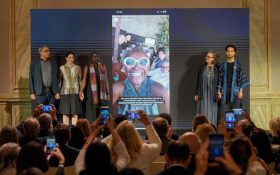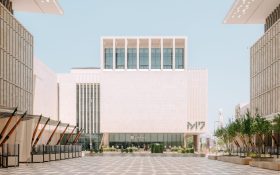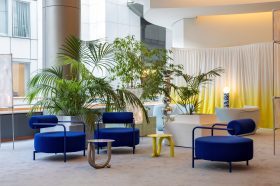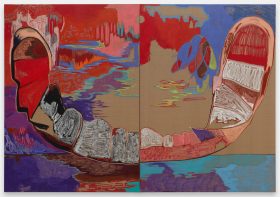For most people, shopping malls would be generally regarded as existing at pretty much the polar opposite end of the spectrum to most respectable arts practice. Yet in the extreme environment around the Persian Gulf, where the average daytime Summer temperature tops 45 degrees Celsius, shopping malls are an essential retreat from the heat that blows in from the desert.
My local shopping mall, in walking distance from my apartment, features in its main atrium a five story high replica of London’s Tower Bridge on one side and a rainforest waterfall on the other – and that’s in a mall that is generally regarded as pretty low budget affair. Most Dubai malls today often resemble small cities rather than the sort of large shop filled barn-like affairs found in most of the rest of the world.
Shopping malls themselves are a cultural phenomenon here in Dubai, a spectacular blend of excess and convenience, featuring all of the top names in luxury, like Saks Fifth Avenue, Harvey Nicholls, Louis Vuitton and De Beers alongside garden variety supermarkets and fast food chains like McDonalds, Subway and Pizza Hut. Mega malls such as the Mall of the Emirates, Festival City, Ibn Battuta, Wafi City, the Madinat Jumeriah and the Burjuman form a network of plush indoor towns, each featuring a range of shops from the luxury to the mundane, hotels, cinemas, supermarkets, food courts and services.
Malls in Dubai are an essential element of public life, providing a public communal space that crosses over boundaries between commerce, community, entertainment and the arts industries.
When Cirque du Soleil came to Dubai recently, it didn’t pitch its tent in a well manicured park or set up shop in the Albert Hall, rather it’s home location was at the Ibn Battuta Mall, a sprawling affair with different national themed sections, from the Chinese theatre area, to the Persian dome and the Tunisian supermarket district. When musicals such as Stomp and Mama Mia visited Dubai, they were hosted by the Madinat Theatre in the plush Arabian street market style mall at the Madinat Jumeirah hotel complex.
When it comes to malls, the pinnacle of excess is the Mall of the Emirates, it features a five star hotel, a massive indoor ski slope, all of the high fashion names, an enormous Carrefour Hypermarket, several food courts, bars, a Cineplex and every fast food name under the blazing desert sun, a small city of glossy marble corridors wedged between a freeways and building sites. And no city is complete without its artistic community, for the Mall of the Emirates this includes a number of fairly bland commercial galleries but is also one of the hubs of the community arts scene in Dubai.
The Dubai Community Theatre and Arts Centre although located in an exclusive mall, has all the hallmarks of a community arts centre in a wealthy district anywhere else in the world. DUCTAC’s honoary patron is the HRH Princess Haya Bint Al Hussein, the wife of the Ruler of the Emirate of Dubai, HH Sheik Mohammed Bin Rashid al Maktoum, one of the world’s wealthiest men. The non-profit DUCTAC complex opened in 2006 and features a central concert hall, theatres, art gallery spaces and meeting rooms for community arts classes.
Like community arts centres the world over DUCTAC is characterised by wildly varying quality levels. With few other venues for classical music or ballet, the centre is often host to high quality visiting international companies but is also the venue for amateur and student arts practice. The centre offers community arts classes in painting, collage, drawing, pottery, mosaics and sculpture for adults, teens and children. The centre also features gallery spaces for exhibitions from amateur and semi-professional local artists, plus a main concert hall which is used for visiting artists, ballets and debuts for Dubai based music students. The centre also has a studio in which subjects ranging all the way from drama through to dance, drumming, singing and Yoga are taught.
In the midst of the hyper-wealthy, hyper commoditised environment of Dubai, DUCTAC is a refreshingly down to Earth community arts centre, although it’s a little better kitted out than most community arts centres, it could be almost any fairly affluent district in the world – Beverly Hills in California, Chelsea in London or the North Shore of Sydney. While Dubai might be host to an active and expensive arts market, the Emirate also has all the trappings of arts communities throughout the world, even if in Dubai much of that arts practice does happen to take place in shopping malls.




